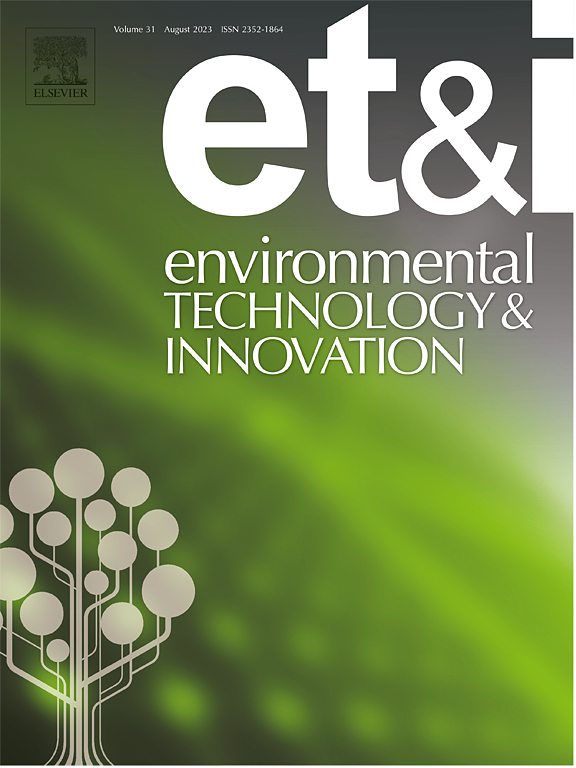An innovative sustainable solution: Recycling shield-discharge waste soil as fine aggregate to produce eco-friendly geopolymer-based flowable backfill materials
IF 7.1
2区 环境科学与生态学
Q1 BIOTECHNOLOGY & APPLIED MICROBIOLOGY
引用次数: 0
Abstract
The disposal of Shield-Discharge Waste Soil (SDWS) is substantial, yet their recycling rate remains low, necessitating the exploration of new recycling methods for effective waste management. This study examines the potential use of SDWS as a fine aggregate in the production of Controlled Low-Strength Material (CLSM), incorporating slag and fly ash as precursors. Key properties such as strength, flowability, setting time, microstructure, chemical composition, CO2 emissions, energy consumption, and cost were assessed and analyzed. Additionally, the environmental impact and material-related strategies were discussed. The results reveal that the developed CLSM exhibits competitive performance, with compressive strengths ranging from 2.830 MPa to 4.121 MPa, achieving over 1.0 MPa strength within 24 hours. The material demonstrates high flowability, exceeding 200 mm within 30 minutes, and has a setting time between 2.10 and 4.23 hours, offering advantages in both setting time and early strength. SDWS contributes to extending the coagulation process and enhancing the flowability. Optimal strength is observed when SDWS constitutes approximately 30 % of the binders or when the alkali equivalent is around 7 %. Compared to traditional cement-based CLSMs, incorporating SDWS results in reduced CO2 emissions and lower energy consumption. When considering savings from reduced waste disposal costs, the overall material cost remains competitive. Furthermore, higher SDWS content leads to enhanced environmental benefits, and it is recommended to keep the alkali equivalent below 7 % for optimal performance. In conclusion, the developed CLSM presents significant potential for wide-scale applications and offers a sustainable solution for recycling SDWS.
创新的可持续解决方案:回收利用盾构排水废土作为细骨料,生产环保型土工聚合物可流动回填材料
盾构排水废土(SDWS)的处理量很大,但其回收利用率仍然很低,因此有必要探索新的回收利用方法,以实现有效的废物管理。本研究探讨了在生产受控低强度材料(CLSM)过程中将 SDWS 用作细骨料的可能性,并将矿渣和粉煤灰作为前驱体。对强度、流动性、凝结时间、微观结构、化学成分、二氧化碳排放量、能耗和成本等关键性能进行了评估和分析。此外,还讨论了环境影响和材料相关策略。研究结果表明,所开发的 CLSM 具有极佳的性能,抗压强度从 2.830 兆帕到 4.121 兆帕不等,在 24 小时内可达到 1.0 兆帕以上的强度。该材料具有很高的流动性,30 分钟内的流动性超过 200 毫米,凝结时间在 2.10 至 4.23 小时之间,在凝结时间和早期强度方面都具有优势。SDWS 有助于延长凝结过程并提高流动性。当 SDWS 约占粘结剂的 30% 或碱当量约为 7% 时,可观察到最佳强度。与传统的水泥基水泥拌合物相比,掺入 SDWS 可减少二氧化碳排放量,降低能耗。考虑到因减少废物处理成本而节省的费用,总体材料成本仍然具有竞争力。此外,SDWS 含量越高,环境效益越大,建议将碱当量保持在 7% 以下,以获得最佳性能。总之,所开发的 CLSM 具有广泛应用的巨大潜力,并为回收利用 SDWS 提供了一种可持续的解决方案。
本文章由计算机程序翻译,如有差异,请以英文原文为准。
求助全文
约1分钟内获得全文
求助全文
来源期刊

Environmental Technology & Innovation
Environmental Science-General Environmental Science
CiteScore
14.00
自引率
4.20%
发文量
435
审稿时长
74 days
期刊介绍:
Environmental Technology & Innovation adopts a challenge-oriented approach to solutions by integrating natural sciences to promote a sustainable future. The journal aims to foster the creation and development of innovative products, technologies, and ideas that enhance the environment, with impacts across soil, air, water, and food in rural and urban areas.
As a platform for disseminating scientific evidence for environmental protection and sustainable development, the journal emphasizes fundamental science, methodologies, tools, techniques, and policy considerations. It emphasizes the importance of science and technology in environmental benefits, including smarter, cleaner technologies for environmental protection, more efficient resource processing methods, and the evidence supporting their effectiveness.
 求助内容:
求助内容: 应助结果提醒方式:
应助结果提醒方式:


